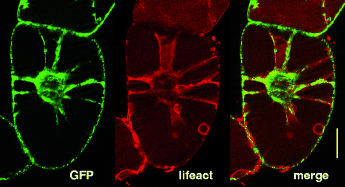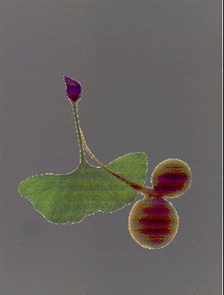Chemical Engineering of plant cells
What is the topic?
Via genetic engineering cells can be manipulated by various manner. However, this strategy only allows for global changes. To study the genesis of cellular "direction", we need tools that allow to integrate gradients. We therefore work on chemical engineering for plant cells. Especially interesting are peptides, because they can be tailored for specific cellular Targets. But how to get those peptides through cell wall and cell membrane into the cell?
Where are we now?
We have developed, in cooperation with chemists, Trojan Horses that can enter into plant cells and induce specific effects. Together with the lab of Anne Ulrich (CN-IBG) we investigated cell permeating peptides that allow to visualise actin filaments (Eggenberger et al. 2011) or, by use of an ancient peptide from the Ginkgo tree, to persuade cells to comit suicide (Gao et al. 2016). Together with the labs of Stefan Bräse and Ute Schepers (CN-ITG) we have identified "Trojan Peptoids" (these are peptide mimicking structures, where the side chains are attached not at the carbon, but at the nitrogen of the peptidic bond) that are targeted to plant mitochondria.
Our current focus
Together with the Schepers lab we work on peptoids that enter mitochondra, where oxygen is reduced to water at the inner membrane. We expect that this process will be modulated leading to modulated levels of reactive oxygen species (ROS). These oxygen species are often discussed as cause of cellular damage and ageing, whereby it is often overlooked that ROS are central signals for the adaptation to stress. By coupling molecules that quench reactive oxygen species, we should be able to alter stress responses. We investigate this using salinity stress in tobacco as a model. In addition to normal cells we also use lines, where different steps of jasmonate synthesis are altered. Jasmonate is the functional plant version of adrenalin, a central stress hormone. But also its precursor, OPDA, has now been recognised as signal of its own virtue that can steer programmed cell death and closely connects with ROS. This jasmonate precursor is converted by the enzyme OPDA-Reductase, such that this enzyme is something like a switch between different salinity responses. We have therefore generated a cell line, where this enzyme is upregulated in a fluorescent form, such that we can observe it. In fact, this line can cope better with salt stress as compared to the "wild type". In the next step we want to use chemical engineering to tailor this process. For this purpose, we use a Trojan Peptoid coupled to a compound used in cosmetics as antioxidant to prevent ageing of human skin.
Publications on this topic
73. Eggenberger K, Schröder T, Birtalan E, Bräse S, Nick P (2009) Passage of Trojan Peptoides into Plant Cells. ChemBioChem 10, 2504-2512 - pdf
82. Eggenberger K, Mink C, Wadhwani P, Ulrich AS, Nick P (2011) Using the peptide BP100 as a cell penetrating tool for chemical engineering of actin filaments within living plant cells. ChemBioChem 12, 132-137 - pdf
98. Liu Q, Qiao F, Ismail A, Chang X, Nick P (2013) The Plant Cytoskeleton Controls Regulatory Volume Increase. BBA Membranes1828, 2111–2120 - pdf
118. Gao N, Wadhwani P, Mühlhäuser P, Liu Q, Riemann M, Ulrich A, Nick P (2015) An antifungal protein from Ginkgo biloba binds actin and can trigger cell death. Protoplasma 235, 1159-1174 - pdf
128. Eggenberger K, Sanyal P, Hundt S, Wadhwani P, Ulrich AS, Nick P (2016) Challenge Integrity: The Cell-Permeating Peptide BP100 Interferes With The Actin-Auxin Oscillator. Plant Cell Physiology. doi 10.1093/pcp/pcw161 - pdf


